Welcome to our blog for the Plastic in the Pacific Crusade. If you missed the earlier editions please use the category search in the footer to go back and read them. They are listed under Plastic in the Pacific. Over the coming year we will be writing regularly of our adventures and what we are seeing. In this article we write about our Spanish Mainland Adventures
In our last edition we left you as we were sailing across from Italy towards Spain. It is a 680nm journey and we were sailing along in a good breeze of 20-30 knots. It was awesome sailing as it was quick but with very little effort. O.K it gets a bit rolly in the swells that build up over time, but when you don’t have a headsail out, you just sail along with the main at speed and it is comfortable and stress free. You have to remember that we are cruising and the least amount of stress on boat and crew the better.
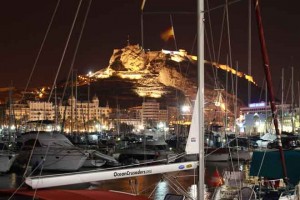 As we approached the Spanish coast near Alicante we started to see the lights as night approached. There was quite a bit of shipping traffic as we passed through the main shipping channel off the coast. Along with this came a lot of cloud and eventually the rain. We actually thought the rain would be great as after 6 days it would clean the boat of all the salt. Little did we know about ‘Red Rain’. We sailed into Marina Alicante and pulled up at the waiting berth, clearly labelled which was great. Easy to pull up at 3am in the morning and you have power and water there. We of course went to sleep to wake up in the morning a bit more fresh. Waking up to a red boat is something we are used to with red covers and red stripes but when the boat is covered in red dirt, it is a bit unusual. The rain the previous night was full of red dirt from the Sahara desert, a common issue on the East coast of Spain. At least we had water to wash it down.
As we approached the Spanish coast near Alicante we started to see the lights as night approached. There was quite a bit of shipping traffic as we passed through the main shipping channel off the coast. Along with this came a lot of cloud and eventually the rain. We actually thought the rain would be great as after 6 days it would clean the boat of all the salt. Little did we know about ‘Red Rain’. We sailed into Marina Alicante and pulled up at the waiting berth, clearly labelled which was great. Easy to pull up at 3am in the morning and you have power and water there. We of course went to sleep to wake up in the morning a bit more fresh. Waking up to a red boat is something we are used to with red covers and red stripes but when the boat is covered in red dirt, it is a bit unusual. The rain the previous night was full of red dirt from the Sahara desert, a common issue on the East coast of Spain. At least we had water to wash it down.
In most of our previous stop overs we had been really disappointed with the marinas and towns. Arriving in Alicante we had very high expectations, after all it was the home of the Volvo Ocean Race, one of the reasons we had planned to go into Alicante in the first place. And finally we were not let down. The marina was fantastic, prices weren’t bad, the cost of diesel was reasonable again and the people were really helpful and friendly. The marina was full so they struggled to find a berth for us but we were actually happy to stay on the waiting berth anyway. We were able to find good chandleries in the marina and the grocery stores were only a short walk away.
 One thing that stood out when we went grocery shopping was a bad habit that our new generation has become used to. We seem to think that packaging fresh fruit and vegetables on polystyrene trays and wrapped in cling wrap is a good way to keep food fresh. It is a shocking habit and creates so much needless waste. Getting the fruit and vegies from the store to home is not the dirty part of the journey. The pesticides and the amount of people who handle the goods means you should wash them before you eat them anyway so why create all this needless waste which will never disappear. In fact the packaging would end up leeching into the goods and that will make it toxic after a short time. We tried to buy some fruit that wasn’t packaged in this way only to be forced into using plastic bags. We said we didn’t want the plastic bags but they said we had to for security, they didn’t want us adding more to the bag after it had been labelled. We were stuck between a rock and a hard place. We opted for the plastic bags as we knew we could at least reuse them. We hope to get back to Spain one day and educate them and hopefully change their habits.
One thing that stood out when we went grocery shopping was a bad habit that our new generation has become used to. We seem to think that packaging fresh fruit and vegetables on polystyrene trays and wrapped in cling wrap is a good way to keep food fresh. It is a shocking habit and creates so much needless waste. Getting the fruit and vegies from the store to home is not the dirty part of the journey. The pesticides and the amount of people who handle the goods means you should wash them before you eat them anyway so why create all this needless waste which will never disappear. In fact the packaging would end up leeching into the goods and that will make it toxic after a short time. We tried to buy some fruit that wasn’t packaged in this way only to be forced into using plastic bags. We said we didn’t want the plastic bags but they said we had to for security, they didn’t want us adding more to the bag after it had been labelled. We were stuck between a rock and a hard place. We opted for the plastic bags as we knew we could at least reuse them. We hope to get back to Spain one day and educate them and hopefully change their habits.
Through Rob Kothe from Sail-World.com we had arranged a meeting with Jon Bramley from Volvo Ocean Race. Their offices were at the marina. One of our goals is to be involved in this race to help them educate people of the issues of plastic in our oceans. Having been to the Oceans Seminar in Gothenburg and seen the passion the event has, we think we can help them lift their game to the next level. So our meeting with Jon was to introduce who we were and how we can possibly assist. The latest update is they are developing a plan for the next edition and let’s hope that Ocean Crusaders are able to help them with that plan, that would be amazing for our organisation and even better for the environment. After the meeting we walked through the Race Museum. If every you are in Alicante, it is a must do. So much history and quite interactive.
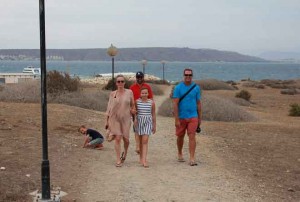 We also had the pleasure of hosting Annika’s sister Susanne and her family. They flew down from Switzerland on the Friday evening and joined us for the whole weekend. Saturday morning the ladies and kids went shopping for some extra food whilst Daniel and I washed the boat down and got ready to head out to sea. We took off late morning towards a little island called Tarbarca, just 9nm south of Alicante. It was a really good breeze, beam reaching in 15-20 knots. Young Tim is 5 years old and has a fear of waves. Sitting in his life jacket in the arms of his dad, he was crying as we hit the first waves leading out of the marina. As he got more and more confidence, the crying stopped and before you knew it he was loving the ride. It was great to have helped him over a little fear he had. Meanwhile Moa, the elder sister was feeling a bit seasick but a few happy songs and she started to forget about that. Making our guests comfortable was key and by the time we arrived at the back of Tarbaca and dropped the anchor, everyone was having a great time.
We also had the pleasure of hosting Annika’s sister Susanne and her family. They flew down from Switzerland on the Friday evening and joined us for the whole weekend. Saturday morning the ladies and kids went shopping for some extra food whilst Daniel and I washed the boat down and got ready to head out to sea. We took off late morning towards a little island called Tarbarca, just 9nm south of Alicante. It was a really good breeze, beam reaching in 15-20 knots. Young Tim is 5 years old and has a fear of waves. Sitting in his life jacket in the arms of his dad, he was crying as we hit the first waves leading out of the marina. As he got more and more confidence, the crying stopped and before you knew it he was loving the ride. It was great to have helped him over a little fear he had. Meanwhile Moa, the elder sister was feeling a bit seasick but a few happy songs and she started to forget about that. Making our guests comfortable was key and by the time we arrived at the back of Tarbaca and dropped the anchor, everyone was having a great time.
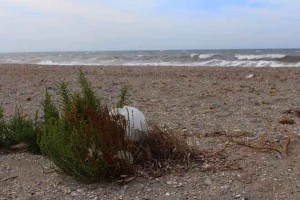 We had a bite to eat and then set off to explore the island. It was beautiful in the city however the Eastern end was quite sparse with lots of dead shrubs and amongst these shrubs was a lot of plastic in the form of bottles and bags. It was really annoying to see as the place was a huge tourist destination and the beach had the blue tick, a program to say they are clean. Well I can tell you that if I was awarding that program I’d be having a chat with the islands people to say ‘clean up your act’. However the township was awesome. We felt like we should have been in a western. Unfortunately the church was under repair so we didn’t get to see inside that which would have been great.
We had a bite to eat and then set off to explore the island. It was beautiful in the city however the Eastern end was quite sparse with lots of dead shrubs and amongst these shrubs was a lot of plastic in the form of bottles and bags. It was really annoying to see as the place was a huge tourist destination and the beach had the blue tick, a program to say they are clean. Well I can tell you that if I was awarding that program I’d be having a chat with the islands people to say ‘clean up your act’. However the township was awesome. We felt like we should have been in a western. Unfortunately the church was under repair so we didn’t get to see inside that which would have been great.
That night the rain came in and in the morning we decided to head over to Santa Pola to the marina there. It was a quick sail of just 4nm and arriving in the marina, the rain had just stopped. There are two sections to the marina, the old Club Nautico side and the new Marina Mirimar side. We chose the new side and the facilities were awesome. Berthing costs were around €30 a night for us and water and electricity would be extra. There was a line of restaurants along the waterfront and the place was quite clean. Being a Sunday a lot of things were closed. Annika’s mum Siv flew in from Sweden that afternoon and joined us. The following morning it was time to say good bye to the family. It was great to have had them onboard and shown them our boat. Mum would stay with us for the trip down to the Canaries.
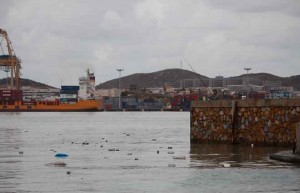 We departed Santa Pola mid morning and sailed the 45nm down to Cartegena. We knew that the rain had been quite intense down in this region however we had no idea how much. There had apparently been a lot of flash flooding and as we approached the marina in Cartegena, the water changed from pure clear to murky brown, littered with so much debris. This was the wash out where all our sins from the land end up in the ocean. All the drains led to the water and hence water bottles, straws and all sorts of food packages had washed out. It was disgusting, yet people were still fishing off the point. We decided to stay at Yacht Port Cartegena and found a well sheltered berth a fair way in. The outer berths had a reputation of being quite rolly. Cost was just €22 a night which was very reasonable and the facilities were quite good. The best thing was they had recycling bins for everything to separate and segregate our rubbish.
We departed Santa Pola mid morning and sailed the 45nm down to Cartegena. We knew that the rain had been quite intense down in this region however we had no idea how much. There had apparently been a lot of flash flooding and as we approached the marina in Cartegena, the water changed from pure clear to murky brown, littered with so much debris. This was the wash out where all our sins from the land end up in the ocean. All the drains led to the water and hence water bottles, straws and all sorts of food packages had washed out. It was disgusting, yet people were still fishing off the point. We decided to stay at Yacht Port Cartegena and found a well sheltered berth a fair way in. The outer berths had a reputation of being quite rolly. Cost was just €22 a night which was very reasonable and the facilities were quite good. The best thing was they had recycling bins for everything to separate and segregate our rubbish.
Cartegena was a destination for two reasons. First of all the old ruins and township were apparently something well worth seeing and secondly, it was the closest port to Rob Kothe and his fiancée Jedda, the team from Sail-world.com Rob has been a great help to our campaign and taught me a lot about writing for the media and of course we had been their representatives in Gothenburg for the final stop of the Volvo Ocean Race. The first day Annika and Siv took a short walk into town whilst I caught up on some computer work. They came back raving about the town. The next day we took a further walk into town and then met Rob and Jedda back on the boat. After a quick tour of our yacht, they took us to lunch at a little seaside town of Cabo De Palos. I had seen that there was a small marina there and had asked Rob about it as an option for visiting them however he told me that the entrance to the marina was a bit tricky. He wasn’t wrong. Considering the swell and the right hand turn just before you hit the rocks, it wasn’t a place I would have attempted. I know I would have aborted well before I got close. Even having seen it from the land, I’m not sure I’d try it with any seaway at all, not on a keel yacht anyway.
We had an enjoyable lunch as a huge storm passed over dumping its rain on us and then heading onto Cartegena where we had left a few hatches ajar on the yacht, so we knew there would be a bit of rain inside when we got back. It was awesome catching up with Rob and meeting Jedda for the first time. In the past we have only met on business but this time it was purely pleasure and it was good fun. On the way home they dropped us at a huge supermarket and we shopped for our Atlantic Crossing as we didn’t know what facilities or shops would be available further south. We then got a taxi home and enjoyed our evening on the yacht.
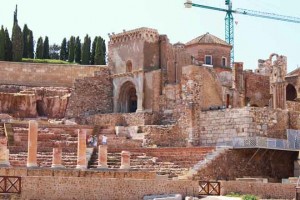 The next morning we would go and see a few more sites including some historical buildings and then we had a late lunch appointment with Rob & Jedda. They picked us up and we went back to their place at Los Alcazares. This is a little town on the inland side of Mar Menor, a huge inland stretch of water. Their place was a few doors down from the beach. It was an awesome afternoon and evening as we ate Garlic Prawns, Gazpacho (Spanish Soup) and other delights. They had even produced a homemade almond milk which Annika and Siv loved.
The next morning we would go and see a few more sites including some historical buildings and then we had a late lunch appointment with Rob & Jedda. They picked us up and we went back to their place at Los Alcazares. This is a little town on the inland side of Mar Menor, a huge inland stretch of water. Their place was a few doors down from the beach. It was an awesome afternoon and evening as we ate Garlic Prawns, Gazpacho (Spanish Soup) and other delights. They had even produced a homemade almond milk which Annika and Siv loved.
The next day and it was time to depart from Cartegena to Almerimar on the south coast. We had been recommended to see a guy there for our rigging inspection by the crew off Orion, an Australian Beneteau 473 that were heading south to do the ARC. (Atlantic Rally Cruise). We needed the rigging inspection for insurance. I wasn’t about to cross the Atlantic without being fully insured. We departed at midday for an overnight sail, planning to arrive first thing in the morning. The distance was too much for a day sail so this was our best option. The winds started off light but filled in overnight and we cruised along with 10-15 knots all the way to the marina in Almerimar.
We already knew it wasn’t a place of much to do other than prepare a yacht for an Atlantic Crossing. We pulled into the fuel berth whilst we waited for the marina to open. The marina office is an old style light house. Very attractive and the facilities were very good. We got our berth which was €19 per night plus taxes. It was right across the road from an Italian restaurant and another bar so we got free wifi the whole time we were there. We found Andy Parkinson the rigger from the local shop to come and inspect our rig. He came fairly well straight away which was awesome. He picked up that our forestay had been overwound at the top and we knew we had been having issues with our halyward swivel, a device that allows our headsail to furl up. It had been jamming leaving us with a hard time to furl or unfurl our headsail, something you don’t want crossing the Atlantic. This was probably the cause of the forestay issue too.
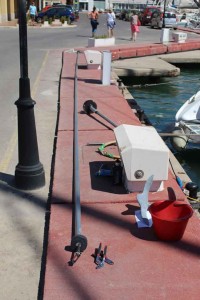 So we had to order a new forestay and halyard swivel. We also had some turnbuckles that were basically buckles as they didn’t turn. We managed to free a couple with heat but some of them needed to be cut off and replaced which we did. Annika and I spent a whole day cleaning them and tuning the rig again which was nice to finally get some good tension on all wires. When Andy came back with the price on the halyard swivel I nearly fell over. €840 for a new halyard swivel. Time to name and shame. Facnor, and yes you can pronounce it the way I do now, have this one halyard swivel that they have had so many issues with it is incredible. They’ve actually produced a replacement for it so they know the issue. Andy had already done several and even Orion was in need of a replacement. When you design something without the ability to lube the bearings, then I believe it is designed to fail. The only way to lube them is to have special tools that even Andy didn’t have as a qualified rigger. It is crazy and I will publicly shame Facnor for this. I gave them a right of reply by writing to them but they didn’t even give me a response so they obviously don’t care. If you’ve got facnor gear or are thinking of buying a new facnor furler, forget it, go with something more reliable like furlex or profurl.
So we had to order a new forestay and halyard swivel. We also had some turnbuckles that were basically buckles as they didn’t turn. We managed to free a couple with heat but some of them needed to be cut off and replaced which we did. Annika and I spent a whole day cleaning them and tuning the rig again which was nice to finally get some good tension on all wires. When Andy came back with the price on the halyard swivel I nearly fell over. €840 for a new halyard swivel. Time to name and shame. Facnor, and yes you can pronounce it the way I do now, have this one halyard swivel that they have had so many issues with it is incredible. They’ve actually produced a replacement for it so they know the issue. Andy had already done several and even Orion was in need of a replacement. When you design something without the ability to lube the bearings, then I believe it is designed to fail. The only way to lube them is to have special tools that even Andy didn’t have as a qualified rigger. It is crazy and I will publicly shame Facnor for this. I gave them a right of reply by writing to them but they didn’t even give me a response so they obviously don’t care. If you’ve got facnor gear or are thinking of buying a new facnor furler, forget it, go with something more reliable like furlex or profurl.
As the weekend came, there was no way of getting the parts till early the next week. For some reason they build forestays on Mallorca in Spain. No idea why they can’t produce them on the mainland. Some days I would go around the marina collecting the rubbish that was blowing from the shops into the water. On one occasion a family was feeing the fish and there was rubbish all around them. The main beach in Almerimar was also very dirty with lots of small pieces of plastic on it and amongst the rocks. It’s such a shame that people just have no idea the consequences of buying products in plastic.
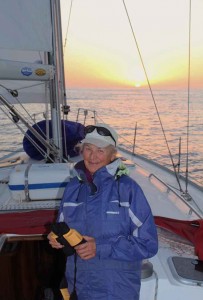 We got everything on the Tuesday and proceeded to do the work ourselves as I have had a lot of experience rigging yachts from my importing Catalina days. Andy oversaw everything to make sure we did everything right. The process involved removing the forestay with furler attached. Then we had to dismantle the furler and tubes which wasn’t too easy as screws had been secured well by the salt water corrosion over the years. We then had to install everything back on the new forestay and put it back up. It was an all day mission which was very tiring for both Annika and I. Meanwhile Siv was working away at sanding back our teak seats in the cockpit to remove the varnish. She did such a good job and the seats look so much better now.
We got everything on the Tuesday and proceeded to do the work ourselves as I have had a lot of experience rigging yachts from my importing Catalina days. Andy oversaw everything to make sure we did everything right. The process involved removing the forestay with furler attached. Then we had to dismantle the furler and tubes which wasn’t too easy as screws had been secured well by the salt water corrosion over the years. We then had to install everything back on the new forestay and put it back up. It was an all day mission which was very tiring for both Annika and I. Meanwhile Siv was working away at sanding back our teak seats in the cockpit to remove the varnish. She did such a good job and the seats look so much better now.
We eventually would be ready to depart for the Canaries on the 18th September. We fuelled up and headed off on what was to be our longest journey so far, 820nm through the straits of Gibraltar and into the Atlantic Ocean. The forecast was for good winds all the way. Once we were through the straits the wind would come behind us and we would be sailing downwind to Lanzarote to drop off a bottle of wine.
I had researched this trip and the straits of Gibraltar are a tricky waterway. What we would face would make our learning curve even steeper.
In our next edition we sail through the straits of Gibraltar and onto the Canary Islands, exploring a couple of the islands unique landscape whilst preparing for the Atlantic Crossing.
Ocean Crusaders are out to change the way people treat our oceans. Our online education program is free to download at www.OceanCrusaders.org/education where children can learn of the issues our oceans are facing and how they can make a difference. The Plastic in the Pacific Crusade is about educating the South Pacific Islands, finding out what is happening in these islands and updating our programs. You can join us in the Pacific and see for yourself what we do.
Ocean Crusaders Plastic in the Pacific Crusade is proudly supported by: Cressi Dive Gear, Gill Marine, Keen Footwear Australia, Barz Optics Sunglasses, Maxsea Navigation Software, Digital Diver Cairns, LED Dive Lights Australia, Boat Names Australia & Predictwind Weather
[cincopa AIIA9ANbSekv]